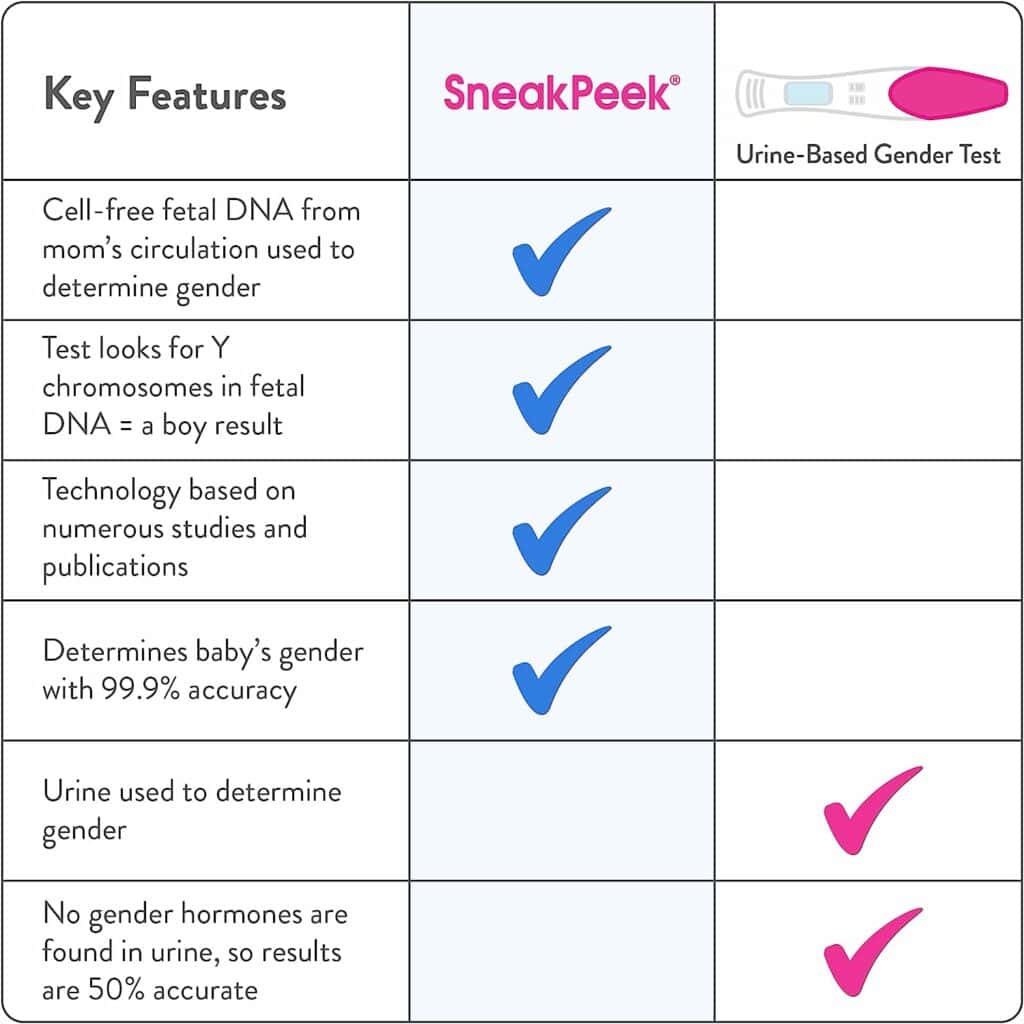Sneak Peek Test is a popular early gender determination test that has gained immense popularity in recent years. With the ability to detect the gender of the baby as early as 8 weeks, many expectant parents are eager to take the test to find out if they are having a boy or a girl. However, the question remains: what happens if you do Sneak Peek too early?
Early Sneak Peek Testing: What It Means
While the idea of finding out the gender of the baby early on may seem exciting, it’s important to understand the implications of taking the test too early. The Sneak Peek Test analyzes fetal DNA present in the mother’s blood to determine the gender of the baby. However, at very early stages of pregnancy, the amount of fetal DNA in the mother’s blood may not be sufficient for an accurate result. This means that taking the test too early can result in an inconclusive or inaccurate result.
Accuracy of Sneak Peek Test
The accuracy of the Sneak Peek Test is largely dependent on the timing of the test. While the test claims to have a 99.1% accuracy rate, this is only true when the test is taken at the recommended time. Taking the test too early can lead to a false result, which can be disappointing and stressful for expectant parents.
Key Takeaways
- Taking the Sneak Peek Test too early can result in an inconclusive or inaccurate result.
- The accuracy of the Sneak Peek Test is largely dependent on the timing of the test.
- It’s important to wait until the recommended time to take the test for the most accurate results.
Understanding Sneak Peek Test
Sneak Peek is an early gender DNA test that allows pregnant women to determine the gender of their baby as early as 8 weeks into pregnancy. The test is available in two versions: a home test kit and a clinical version that is administered by a healthcare provider.
The home test kit is designed to be simple and easy to use. It involves collecting a small sample of blood from the mother’s fingertip and sending it to a laboratory for analysis. The results are typically available within 72 hours.
The clinical version of the test is more accurate and reliable than the home test kit. It involves a blood draw that is performed by a healthcare provider and sent to a laboratory for analysis. The results are typically available within 24-48 hours.
It is important to note that the Sneak Peek test is a genetic test, and as such, it has a small risk of causing a miscarriage. While the risk is low, it is important for pregnant women to understand the potential risks before deciding to take the test.
Overall, the Sneak Peek test can be a useful tool for parents who are eager to learn the gender of their baby early in pregnancy. However, it is important to weigh the potential risks and benefits before deciding to take the test.
Early Sneak Peek Testing: What It Means
Early sneak peek testing refers to the process of testing a pregnant woman’s blood to determine the sex of the fetus before the standard 20-week ultrasound. This type of testing can be done as early as 6 weeks of gestation and provides an early look at the baby’s gender.
While early sneak peek testing can be exciting for expectant parents who are eager to know the sex of their baby, it is important to understand the potential risks and limitations of this type of testing.
One potential risk is the possibility of a false result, which can occur if there is not enough fetal DNA in the mother’s blood sample or if the sample is contaminated. Additionally, early sneak peek testing does not screen for chromosomal abnormalities or other genetic disorders that may be detected through standard prenatal testing.
It is also important to note that early sneak peek testing is not regulated by the FDA and is not considered a diagnostic test. Therefore, it should not be used as a substitute for standard prenatal care or as a means of making important medical decisions.
Overall, while early sneak peek testing can provide an early look at the baby’s gender, it is important to approach this type of testing with caution and to discuss any concerns or questions with a healthcare provider.
Accuracy of Sneak Peek Test
The accuracy of the Sneak Peek test is an important factor to consider before taking the test. The test claims to have a 99.9% accuracy rate in determining the gender of the baby, but there are several factors that can affect the accuracy of the test.
One of the main factors that can affect the accuracy of the Sneak Peek test is the timing of the test. If the test is taken too early, before the 8th week of pregnancy, there is a higher chance of getting an inconclusive result. This is because the fetal DNA in the mother’s blood is not yet sufficient to provide an accurate gender result.
Another factor that can affect the accuracy of the test is the presence of male DNA in the mother’s blood. If the mother has a male partner or has had a recent male pregnancy, there is a chance that male DNA can be present in her blood, which can affect the accuracy of the test.
It is also important to follow the instructions carefully when taking the test, as any contamination of the sample can affect the accuracy of the test. It is recommended to clean the testing area thoroughly and to avoid touching the inside of the test tube or the swab with bare hands.
Overall, while the Sneak Peek test claims to have a high accuracy rate, it is important to consider the factors that can affect the accuracy of the test. It is recommended to take the test after the 8th week of pregnancy and to follow the instructions carefully to ensure accurate results.

Procedure of Sneak Peek Test
The Sneak Peek test is a non-invasive prenatal test that can be done at home. The test is designed to detect the presence of fetal DNA in the mother’s blood. The procedure involves a finger prick to obtain a blood sample, which is then sent to a lab for analysis.
To perform the test, the mother must first order a kit from the Sneak Peek website. The kit contains a lancet, a snap device, and instructions on how to collect the blood sample. The lancet is used to prick the mother’s finger, and the snap device is used to collect the blood.
Once the blood sample is collected, it is sent to the Sneak Peek lab for analysis. The lab uses a microneedle to extract fetal DNA from the blood sample. The DNA is then analyzed to determine the gender of the baby.
It is important to note that the Sneak Peek test can only be performed after 8 weeks of pregnancy. If the test is done too early, there may not be enough fetal DNA in the mother’s blood for accurate analysis. Additionally, the test should not be performed if the mother is carrying multiple fetuses.
Overall, the Sneak Peek test is a simple and convenient way for mothers to find out the gender of their baby early on in the pregnancy. However, it is important to follow the instructions carefully and to wait until the appropriate time to perform the test.
Potential Contamination Risks
Sneak peek tests require a small blood sample from the mother, which is then analyzed for fetal DNA. However, there is a potential risk of contamination during the sample collection and testing process.
Contamination can occur when the blood sample is not collected and handled properly. For example, if the sample is contaminated with bacteria or other microorganisms, it can affect the accuracy of the test results. It is important to ensure that the sample is collected in a sterile environment and that the collection site is properly disinfected.
Another potential risk is the contamination of the sample with male DNA. This can occur if the mother has had recent contact with male DNA, such as through sexual intercourse. Male DNA can interfere with the accuracy of the test results, particularly if the mother is carrying a male fetus. It is recommended that women avoid sexual activity for at least 24 hours prior to collecting the blood sample.
In addition, there is a risk of contamination with Y chromosome DNA. This can occur if the sample is contaminated with male DNA or if the mother is carrying a male fetus. It is important to note that the presence of Y chromosome DNA does not necessarily indicate that the fetus is male, as it can also be present in female fetuses due to fetal-maternal cell transfer.
Overall, it is important to take precautions to minimize the risk of contamination when collecting and handling blood samples for sneak peek tests. This includes following proper sample collection and handling procedures, avoiding sexual activity prior to sample collection, and ensuring that the testing laboratory has appropriate quality control measures in place.
Understanding Results and Guarantees
When it comes to Sneak Peek tests, it is important to understand the results and guarantees that come with it. The test claims a 99.1% accuracy rate in predicting fetal sex as early as 8 weeks into pregnancy. However, it is important to note that no test is 100% accurate and there is always a chance of error.
In terms of guarantees, Sneak Peek offers a “Boy or Girl Guarantee” which means that if the test result is incorrect, they will refund the cost of the test or send a new test for free. However, this guarantee only applies if the test was taken correctly and the instructions were followed accurately. It is important to read and understand the instructions carefully before taking the test to ensure accuracy.
If the test result is incorrect, Sneak Peek will notify the customer via email. It is important to check your email regularly to ensure that you don’t miss any notifications. If you do not receive a notification within the expected timeframe, you can contact the customer support team for assistance.
It is important to keep in mind that Sneak Peek is a non-invasive test and does not pose any risk to the mother or the fetus. However, it is still recommended to consult with a healthcare provider before taking the test to ensure that it is safe for you and your baby.
In summary, while Sneak Peek offers a high accuracy rate and a guarantee, it is important to understand that no test is 100% accurate and there is always a chance of error. It is also important to follow the instructions carefully and to consult with a healthcare provider before taking the test.
The Role of Ultrasound in Early Gender Determination

Ultrasound is a common medical imaging technique that uses high-frequency sound waves to produce images of the inside of the body. One of the most common uses of ultrasound is to determine the gender of a fetus during pregnancy. However, there are some risks associated with early gender determination that expectant parents should be aware of.
Ultrasound is typically used to determine the gender of a fetus between 18 and 20 weeks of gestation. At this point, the genitalia are developed enough to be visible on the ultrasound image. However, some parents may be eager to find out the gender of their baby earlier than this.
While it is possible to use ultrasound to determine the gender of a fetus as early as 12 weeks of gestation, this is not always accurate. The genitalia may not be fully developed at this point, making it difficult to determine the gender with certainty. In some cases, the ultrasound may even give an incorrect gender prediction.
There are also some risks associated with early gender determination. For example, if a couple is told that they are having a girl based on an early ultrasound, they may start planning for a girl and may be disappointed if the ultrasound turns out to be incorrect. Additionally, some couples may choose to terminate a pregnancy based on the gender of the fetus, which can be a controversial decision.
In conclusion, while ultrasound can be a useful tool for determining the gender of a fetus during pregnancy, there are some risks associated with early gender determination. It is important for expectant parents to discuss the potential risks and benefits of early gender determination with their healthcare provider before making a decision.
Importance of Timing in Sneak Peek Test
Timing is crucial when it comes to taking a sneak peek test. The timing of the test can determine its accuracy and reliability. Taking the test too early can result in false negatives, while taking it too late can result in false positives. Therefore, it is essential to understand the importance of timing in a sneak peek test.
For first-time mothers, it is essential to wait until at least 8 weeks into pregnancy before taking the test. This is because the test measures the presence of fetal DNA in the mother’s blood, which may not be detectable until the placenta has formed. Taking the test too early can lead to inaccurate results and unnecessary anxiety.
It is also crucial to adhere to the limit set by the manufacturer. Sneak peek tests are designed to be taken at a specific time during pregnancy, usually between 9-10 weeks. Taking the test outside this window can lead to inaccurate results.
Patience is key when it comes to taking a sneak peek test. It can be tempting to take the test as soon as possible, but waiting until the appropriate time can ensure accurate results. False negatives can cause unnecessary worry, while false positives can lead to unnecessary medical procedures.
In conclusion, the timing of a sneak peek test is essential to its accuracy and reliability. Waiting until the appropriate time, adhering to the manufacturer’s limit, and having patience can ensure accurate results and avoid unnecessary anxiety and medical procedures.
Community and Sneak Peek Test
The Sneak Peek Test has become increasingly popular in recent years, and with that popularity has come a growing online community of women who have taken the test and are eager to share their results and experiences. This community can be a valuable resource for women who are considering taking the test, as it can provide them with information and support throughout the process.
Participating locations, such as clinics and hospitals, also play a role in this community. These locations offer the Sneak Peek Test to women and are often the first point of contact for those who are interested in taking the test. They can provide women with information about the test and answer any questions they may have.
One aspect of the community that has been particularly helpful for many women is the SneakPeek Snap program. This program allows women to share their test results with others in a private and secure way. It can be a great way for women to connect with others who have taken the test and to share their experiences.
Overall, the community surrounding the Sneak Peek Test can be a valuable resource for women who are considering taking the test. It can provide them with information, support, and a sense of community as they navigate this important decision.
Physical Considerations for Sneak Peek Test
Sneak Peek is a non-invasive prenatal test that can determine the gender of a baby as early as 8 weeks into pregnancy. While the test is generally safe, there are some physical considerations that should be taken into account before deciding to take the test.
Firstly, it is important to note that the test requires a blood sample from the mother. The sample is then sent to a laboratory for analysis. It is important to ensure that the sample is taken by a trained professional to avoid any complications.
Secondly, the test is not recommended for women who have had a recent miscarriage or termination of pregnancy. This is because the test can detect fetal DNA in the mother’s blood, which can still be present after a miscarriage or termination.
Thirdly, the size of the fetus can also affect the accuracy of the test. If the fetus is too small, there may not be enough fetal DNA in the mother’s blood for the test to detect. It is recommended to wait until the fetus is at least 9 weeks old before taking the test.
Fourthly, the test can also be affected by certain factors such as the presence of a leg tattoo or recent blood transfusion. This is because these factors can introduce foreign DNA into the mother’s blood, which can affect the accuracy of the test.
Lastly, it is important to note that the test is not 100% accurate. While the test has a high accuracy rate, there is still a small chance of error. It is important to consider this when making decisions based on the results of the test.
Overall, while the Sneak Peek test is generally safe and accurate, there are some physical considerations that should be taken into account before deciding to take the test. It is recommended to consult with a healthcare professional before taking the test to ensure that it is safe and appropriate for the individual.

Emotional Aspects of Early Sneak Peek Test
Sneak Peek test is a popular method for determining the gender of an unborn baby. While it can be exciting to find out the gender early, there are some emotional aspects to consider before taking the test.
Suspense and Anticipation
One of the main emotional aspects of taking a sneak peek test early is the suspense and anticipation that comes with it. Waiting for the results can be nerve-wracking, and it can be difficult to focus on anything else until the results are in. This can be especially true for expectant parents who are eager to find out the gender of their baby.
Excitement
On the other hand, taking a sneak peek test early can also be exciting. Knowing the gender of the baby can help parents-to-be bond with their child and plan for the future. It can also be an exciting moment to share with family and friends.
Trouble
However, taking a sneak peek test too early can also lead to trouble. The test is not always accurate, and there is a risk of receiving a false result. This can lead to disappointment and confusion, especially if parents have already started planning for a certain gender.
Good Idea and Benefits
Overall, taking a sneak peek test early can be a good idea for some parents-to-be. It can help them plan for the future and bond with their child. However, it is important to remember that the test is not always accurate and to manage expectations accordingly.
In conclusion, taking a sneak peek test early can be an emotional experience for expectant parents. While it can be exciting to find out the gender early, it is important to consider the potential risks and manage expectations accordingly.
Feeding and Sneak Peek Test
Feeding has no effect on the accuracy of the Sneak Peek Test. It is safe to eat and drink before taking the test, and it will not impact the results in any way.
Breastfeeding, however, can potentially affect the results of the test. This is because the Sneak Peek Test detects the presence of Y chromosomes in the mother’s blood, which can come from the male fetus. If the mother is breastfeeding a male child, Y chromosomes from the child’s blood can enter the mother’s bloodstream and potentially affect the results of the test.

It is recommended that mothers wait until they have stopped breastfeeding for at least 6 weeks before taking the Sneak Peek Test to ensure the most accurate results.
Overall, it is important to follow the instructions provided with the Sneak Peek Test to ensure accurate results. While feeding does not affect the test, breastfeeding can potentially impact the results and should be taken into consideration when deciding when to take the test.
Related post: Sneak Peek False Girl Results
Frequently Asked Questions
When is the earliest recommended time to take the SneakPeek test?
The earliest recommended time to take the SneakPeek test is at 8 weeks of pregnancy. This is because the test is designed to detect the presence of male DNA in the mother’s blood, and it takes time for the fetal cells to develop and circulate in the mother’s bloodstream.
What happens if you take the SneakPeek test too early?
If you take the SneakPeek test too early, there is a higher risk of getting a false result. This is because there may not be enough fetal DNA in the mother’s blood to detect the presence of male DNA. It is recommended to wait until at least 8 weeks of pregnancy before taking the test.
Can the SneakPeek test give an inconclusive result if taken too early?
Yes, it is possible to get an inconclusive result if the SneakPeek test is taken too early. This is because there may not be enough fetal DNA in the mother’s blood to detect the presence of male DNA. In this case, the test may need to be repeated at a later time.
What is the accuracy of the SneakPeek test when taken at 6 weeks?
The accuracy of the SneakPeek test when taken at 6 weeks is not as high as when taken at 8 weeks or later. The company claims an accuracy rate of 99% when taken at 8 weeks or later, but the accuracy rate at 6 weeks has not been officially reported.
Is it possible to get a refund if the SneakPeek test is wrong?
Yes, SneakPeek offers a refund if the test result is incorrect. However, there are certain conditions that must be met, such as following the instructions carefully and providing proof of the incorrect result.
What is the SneakPeek calculator and how does it work?
The SneakPeek calculator is a tool provided by the company to help determine the best time to take the test based on the mother’s last menstrual period and the expected due date. The calculator takes into account the length of the mother’s menstrual cycle and the average time of ovulation to estimate the optimal time for testing.

Iesha is a loving mother of 2 beautiful children. She’s an active parent who enjoys indoor and outdoor adventures with her family. Her mission is to share practical and realistic parenting advice to help the parenting community becoming stronger.
